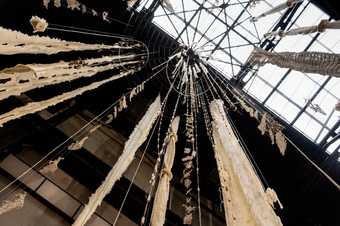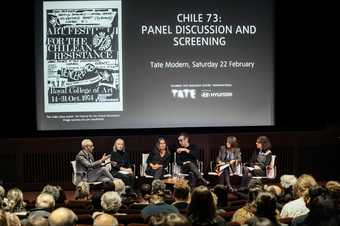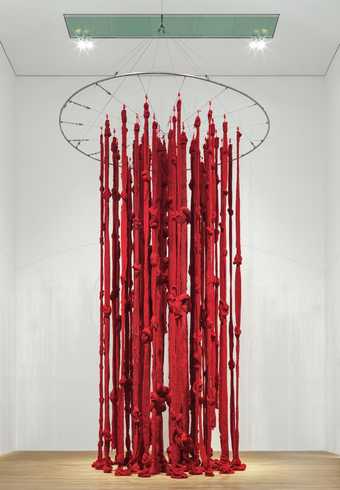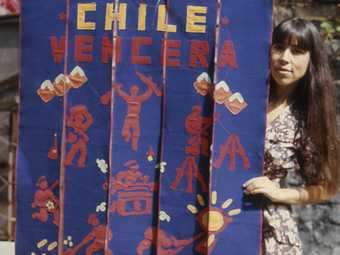
Cecilia Vicuña with maquette for John Dugger’s Chile Vencerá banner © John Dugger Archive
11 September, 1973
In 1973 the world watched as a political crisis unfolded in Chile. The government of Salvador Allende was under siege. Democratically-elected in 1970 as the country’s first socialist president, Allende had pursued a progressive agenda. His government nationalised the copper industry and introduced social and economic welfare for workers and indigenous communities. The country became a centre of a political and cultural experiment that created a great sense of possibility and hope for the socialist agenda, in Chile as well as abroad.
On 11 September 1973 General Augusto Pinochet led a military coup that overthrew the government, leading to Allende’s death. Public outcry and international protests followed.
Pinochet’s dictatorship lasted from 1973 until 1990. According to the Commission of Truth and Reconciliation Report issued in 1991, over 30,000 were direct victims of human rights abuses by the Pinochet government and its secret police, which tortured potential political opponents and executed over 2,000 citizens. In those years many artists left Chile for safer ground; Cecilia Vicuña was one artist who was exiled in London after the coup.
Who is Cecilia Vicuña?
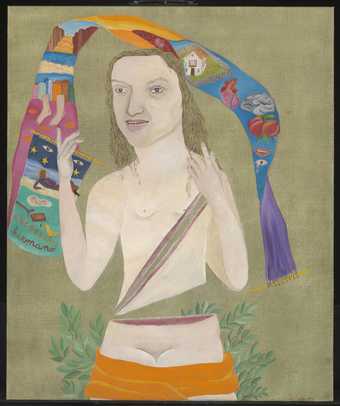
Cecilia Vicuña
Violeta Parra
(1973)
Tate
Cecilia Vicuña was born in Santiago, Chile in 1948 to a family of artists and writers. She began writing and drawing from an early age, with her father building her a large studio so she could paint in her teenage years. From that point onwards, she has consistently referenced the politics of her home country in her writing and visual art. She formed artist collectives to offer vocal support to Salvador Allende’s presidency.
Vicuña then moved to London in 1972 to study at the Slade School of Art on a scholarship. She did not return to Chile after Pinochet’s presidency, feeling that her life would be in danger if she were to return.
The death of Salvador… began to work slowly and mysteriously, cultivating in me something like a seed, a microbe or a sickness. I began to grieve some hours later, when something horrible took shape, like phlegm, a heavy cry…then I began to paint.
Cecilia Vicuña, quoted by Dawn Ades in Cecilia Vicuña's Calcomanías
Art and Protest in London

John Dugger’s Chile Vencerá banner in Trafalgar Square © John Dugger Archive
In May 1974, Vicuña co-founded, together with artists David Medalla and John Dugger, and critic Guy Brett, the artist collective, Artists for Democracy (AFD). This collective was formed specifically to raise support for democracy in Chile after the military coup, as well as to lend support to liberation movements across the world. They used art as a way of making global political struggles visible.
Members of Artists for Democracy continued to organise further protests. In September 1974, one year after the Chilean coup, more than 10,000 people assembled at Hyde Park in London and marched in protest and in solidarity. The protest was co-organised by British trade unions and the Chile Solidarity Campaign, with Vicuña as a member. Those in attendance ranged from members of the public to representatives from trade unions from cities across the UK.
Chilean flags were held at the front of the march, along with protest banners made by both artists and miners. Songs blared as protesters marched across the streets of central London, including 'Venceremos' (meaning ‘we shall prevail’) by Inti Illimani, a Chilean protest song released in 1970 to mark the election of Salvador Allende.
Those who walked from Hyde Park to Trafalgar Square were greeted with a large political banner suspended on Nelson’s Column. The banner was designed and made by John Dugger, with the prominent title of Chile Vencerá, in English, ‘Chile will Prevail’.
Dugger aimed for the banner to carry Vicuña’s ‘message from Chile’: her description of the events in Chile provided him with the themes and political symbolism that he used in the design. The banner was made by Dugger with the assistance of around a dozen young artists and volunteers from the Chile Solidarity Campaign.
Arts Festival for Democracy in Chile, 1974

Lynn MacRitchie videoing the festival opening ceremony, RCA. Photographer unknown © Lynn MacRitchie
Artists for Democracy organised another event in collaboration with artists and activists: Arts Festival for Democracy in Chile at the Royal College of Art in October 1974. Over 600 artworks were donated by artists such as Claes Oldenburg and David Hockney for the festival. Participating artists in the festival included Susan Hiller and Liliane Lijn, who staged the artwork Power Game for the event, with Derek Jarman participating in the performance. Artist and AFD member Lynn MacRitchie recorded the events of the festival using a video camera borrowed from the RCA. The festival ran for two weeks and included discussions, film screenings, poetry readings and dance, music and live art performances.
The videos illustrate the transnational scope of the event. Artists from across the world discussed politics on the African continent and across South America. In one year, the events in one country became a way to bring artists from all over the world and politics together: art became protest.
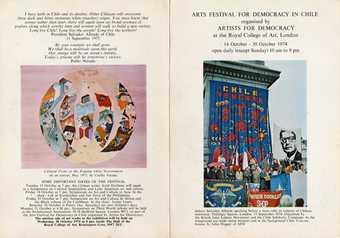
Invitation to the opening ceremony of the Arts Festival for Democracy in Chile, 1974
Other artists respond
In the days after the 1973 coup, the military government suspended the constitution. Thousands of political dissidents in Santiago were silenced, rounded up and taken to the National Stadium and other detention centres. Throughout Pinochet’s rule, the state systematically worked to suppress political opposition. Many artists, writers, intellectuals, trade unionists and politicians went into exile, fearing for their lives. Those who remained in Chile faced limits to personal freedoms, curfews and the threat of constant policing.
Chilean writer Isabel Allende described the atmosphere of the first years under dictatorship:
We were scared, almost paralyzed by fear. There was almost no information, only rumours. We heard about torture centres, concentration camps, assassinations, raids in poor neighbourhoods, how thousands were arrested and many more had fled the country, but there was no way of confirming these rumours. We feared that the phones were tapped and that many people had become informants, so we were cautious when we spoke, even within the extended family.
Since then, generations of Chilean artists such as Lotty Rosenfeld and Alfredo Jaar have continued to reflect upon the events in 1973 and the tense, restrictive experience of life under a dictatorship in the years that followed. Often conceptual art, performance, and ephemeral public actions provided these artists with a means to express resistance and create a sense of community. The work of artists such as Vicuña and those involved in Artists for Democracy - important acts of transnational solidarity - remain visible, with the legacy of one year in Chile’s history remaining of utmost artistic and political importance today.
Research supported by Hyundai Tate Research Centre: Transnational in partnership with Hyundai Motor

